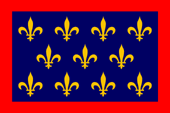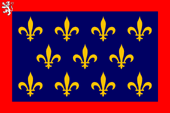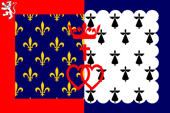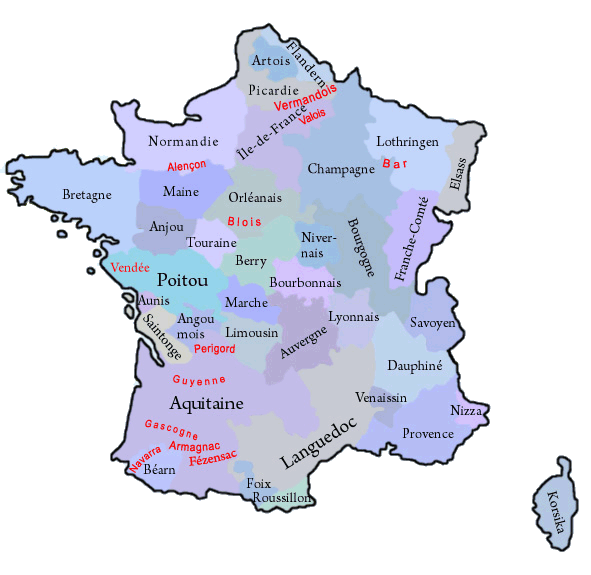mobile View, to the German Version tap the flag


- historical region in today's France
- former county, duchy and province
• Flag
• Meaning/Origin of the Flag
• Coat of Arms
• Meaning/Origin of the Coat of Arms
• Map of the historical Regions in France
• Explanations about the Regions
• History
• Origin of the Country's Name

13th/14th century,
Flag of Maine
– Drapeau de Maine,
Source, by: Wikipedia (FR)




15th century,
Flag of Maine
– Drapeau de Maine,
Source, by: Wikipedia (FR)




from 1960,
Unofficial flag of Pays-de-la-Loire
– Drapeau de officieux de la Pays-de-la-Loire,
Source, by: Wikipedia (FR)






The flag of Maine is a scutcheon-flag, its design is actually the image of the coat of arms of the line of the Valois. Nevertheless, there are flags with a silver lion in the upper corner. Duke Charles I. (1414-1472), who is Duke of Anjou and Maine from 1434, added the previous Valois Crest by a silvery lion in the upper left corner of the coat of arms. Only he has made use of these, because in the time coming after him, in coats of arms, which had Maine as a heraldic sign in it, the lion did not appear again. Nevertheless, the use of the lion in flag and crest seems to have prevailed until today, probably to ensure a better distinction to Valois and Anjou. The in 1960 created Region of "Pays-de-la-Loire", to which Maine belongs, uses an unofficial flag modeled after historical coats of arms. It shows the heraldry of Maine, Anjou, Vendée and Bretagne.
Source:
Volker Preuß,
Wikipedia (D)


1246–1434,
Coat of arms of Maine
– blason de Maine,
Source, by: Wikipedia (D)

1434–1481,
Coat of arms of Maine
– blason de Maine,
Source, by: Wikipedia (D)

The progenitor of the line of Valois, Prince Charles (1270–1325, son of King Philipp III.), Count of Valois, Anjou and Maine, took over the coat of arms from Prince John Tristan (1250–1270, Count of Valois, son of King Ludwig IX.). He surrounded the lily arms of the Capetians with a wide red border. The coat of arms of the Capetians showed three golden lilies on blue, but originally was the coat of arms sprinkled with lilies. From 1365 (by others sources 1376), the number of lilies was reduced to three. The lily-symbol is very old, already the Germanic tribe of the Franks has used it. The House of the Capetians has provided the kings of France between 987 and 1328. It goes back to Hugo Capet, son of Hugo the Great, who was electet to the King of France, in 987, after the death of King Ludwig V. from the House of the Carolingians. The Capetians brought out three branch lines which became the Kings of France: Valois 1328–1589, Bourbon 1589–1792 and 1814–1830, and Orléans 1830–1848. Duke Charles I. (1414-1472), who is Duke of Anjou and Maine from 1434, added the previous Valois Crest by a silvery lion in the upper left corner of the coat of arms. Only he has made use of these, because in the time coming after him, in coats of arms, which had Maine as a heraldic sign in it, the lion did not appear again. Nevertheless, the use of the lion in the crest seems to have prevailed until today, probably to ensure a better distinction to Valois and Anjou.
Source:
Volker Preuß, Wikipedia (D)

The historical, French Regions:

in black: governorate and province in 1776,
in red: former county, province oder governorate
Map: Volker Preuß

The until the French Revolution existing provinces (or governorates) have been historically grown structures, which had their roots oftenly in former fiefdoms of the French crown, historic counties and duchies. They oftenly existed for hundreds of years and had preserved regionality (e.g. cultural particularities and regional languages). On the occasion of the French Revolution such phenomena were of course not desirable, and as part of their bloody and violent egalitarianism any regional references were eliminated. Shortly after the French Revolution the provinces were dissolved and France became divided into many départements, which should have approximately the same size and the same status. The départements were named after rivers or mountains, to use never and in no circumstances the name of an old province. However, there was no success in cutting the connections of the people of France to their respective regions, so that administrative regions were re-created in 1960, to have a better control in regional administrative processes. In this way became départements, which were placed in a historical province, administratively grouped to an oftenly historically named region. The resulted structures coincide only approximately with the boundaries of the old provinces. In the strictly centralist France any regionality is avoided, so that even the official flags of these regions mostly look like flags of companies, unloving, unhistorical, technocratic and modernistic, and these flags should not be a subject of any lexical considerations here. Only in a few of that regions, exist official flags which remember the historical models. But, even the existence of these today's regions is douptful, because in 2014 was passed a territorial reform valid from the year 2016, that reduces the number of the existing regions by merging to nearly the half. However, there exist unofficial flags in nearly all of these regions, which should remember the old provinces and the old heraldry.
Wikipedia Link to the regions of France:
click or tap here
FOTW Link to the regions of France:
click or tap here
Source: Flags of the World,
Wikipedia (D),
Volker Preuß

antiquity · settlement by Celtic tribes, the largest of them are the Aulerkers and Cenomans
56 B.C. · Roman conquest, to the province of Gallia Lugdunensis
5th century A.D. · the west of the country joins the Federation of Armorica to find protection against Germanic invasions, the
east of the country was conquered by the Franks, until 507 (under King Clovis) expansion of the empire to the Atlantic Ocean, the Pyrenees and the Alps
511 · death of King Clovis, division of the Frankish Empire by Salic law of succession among his four sons (residences in Paris, Soissons, Orleans, Reims)
550 · administrative division of the kingdom into the kingdoms of Austrasia, Neustria and Burgundy, today's Maine comes to Neustria
8th century · establishing of the County of Maine, strengthening of the Frankish Empire
832 · Rorgon I., son-in-law of Charlemagne, is Earl, he founds the line of the Rorgonids as Counts of Maine
865 · the first mention of Duke of "Francia", called Robert the Strong, the County of Maine is part of the Duchy of Francia
880 · at the division of the Frankish Empire (Treaty of Verdun and Ribbemont) was created the West Frankish Kingdom (the later France) under a line of the Carolingians
886 · death of Gauzfried, (from the house of Rorgonids), county and title are transferred to Roger (from the house of Robertins)
900 · county and title are transferred from Gauzlin II., last Robertin, to Robert II. (Capetian, Duke of Francia), he enfeoffs Hugh I. (from the House of Rorgonids) with the county, he founds the line of the Counts of the Second House of Maine
987 · death of Louis V. (986–987) from the house of the Carolingians, Hugo Capet, son of Hugo the Great was elected to the King of France and becomes the founder of the Capetian dynasty (Kings of France 987–1328)
1062 · death of Herbert II., Count of Maine, last count from the Second House of Maine, he inherits the county to William the Conqueror (Duke of Normandy)
1063–1070 · reign of Count Robert (son of William the Conqueror, Duke of Normandy) , married with Margaret, sister of Herbert II., he founds the dynasty of the Rollonids as from the Dukes of Normandy fief dependend Counts of Maine
1110 · Count Fulk V. of Anjou (House of Plantagenet) marries Eremburg of Beaugency, the heiress of Maine
1113 · Henry I., son of William the Conqueror, King of England and Duke of Normandy, recognizes Fulk V. as Count of Maine, but the supremacy of Normandy is confirmed
1144 · Geoffrey Plantagenet, son of Fulk V. of Anjou, establishes itself as Duke of Normandy
1150 · Henry II., son of Geoffrey Plantagenet, is Duke of Normandy
1151 · death of Geoffrey Plantagenet, his son Henry II., is Count of Maine, Count of Anjou and Duke of Normandy
1204 · Philip Augustus, King of France, conquers Normandy, Anjou, Maine and Touraine (Angevin Empire of the Plantagenets)
1246 · Louis the Saint, King of France, hands over the County of Maine to his brother Charles of Valois, he founds the line of the counts of Maine from the House of Capet
1328 · death of King Charles IV. (the Fair), extinction of the direct Capetian line, according to Salic Law Count Philip of Valois (Son of Prince Charles of Valois, first cousin of King Charles IV.) came on the French throne (as King Philip VI .), Maine comes thus to the royal domain (royal possessions), the English king Edward III. lays claim to the throne as a maternal nephew of Charles IV., reason for the "Hundred Years War" (Anglo-French War, 1338–1453), out of the House of Valois came all kings of France from 1328 to 1589
1360 · John II., King of France, rises Anjou and Maine to duchies
1380 · death of Charles V. (the Wise), King of France, his brother Louis is indemnifyed with Anjou and Maine as Paragium, he founds the Younger Line of Anjou, he is as Ludwig I. (1339-1384) from 1380 Duke of Anjou and Maine, and from 1382 further Count of Provence, as well as his son Ludwig II. (1377-1417), who has two sons: Ludwig III. (1403-1434) who is 1417-1434 Duke of Anjou and Maine and Count of Provence, and Charles I. (1414-1472) who is from 1434 Duke of Anjou and Maine, his son Charles II. (1436-1481) is from 1472 Duke of Anjou and Maine and Count of Provence, with his death in 1481 the line extincts
1424–1448 · Maine is occupied by the English, John of Lancaster, 1st Duke of Bedford, is Count of Maine
1481 · The Younger Line of Anjou extincts, the land comes back to the Crown, the title of the duke and the country are awarded in the following years as an appanage to royal princes again and again
1776 · the already in the 14th century created governorates of the civil administration of the kingdom of France become committed to a number of 39, and correspond in this way to the number of provinces, in previous years could any provinces be summarized in one governorate
1789 · French Revolution, the governorates (provinces) become abolished, Maine is divided into departments (approximately Sarthe and Mayenne)
1960 · reintroduction of regions in France, formation of the Region of Pays de la Loire with Nantes as capital, but not within the historic boundaries, just by integrating of the departments of Loire-Atlantique, Maine-et-Loire, Mayenne, Sarthe und Vendée
Source:
Wikipedia (D),
Meyers Konversationslexikon

The name "Maine" has its roots in the name of a river in western France. It starts at the city of Angers by the confluence of the rivers Sarthe and Mayenne, runs in a southwesterly direction and flows after 12 km, at Bouchemaine, as a right affluent into the Loire. The River Maine and the river Mayenne had formerly a single Latin name: Mediuna, what means: river of the middle. The landscape and the County of "Maine" has yet another historic name: it was called "Cenomania", a reference to the earlier here living Cenomans.
Source:
Wikipedia (D),
Meyers Konversationslexikon,
Volker Preuß


![]()










